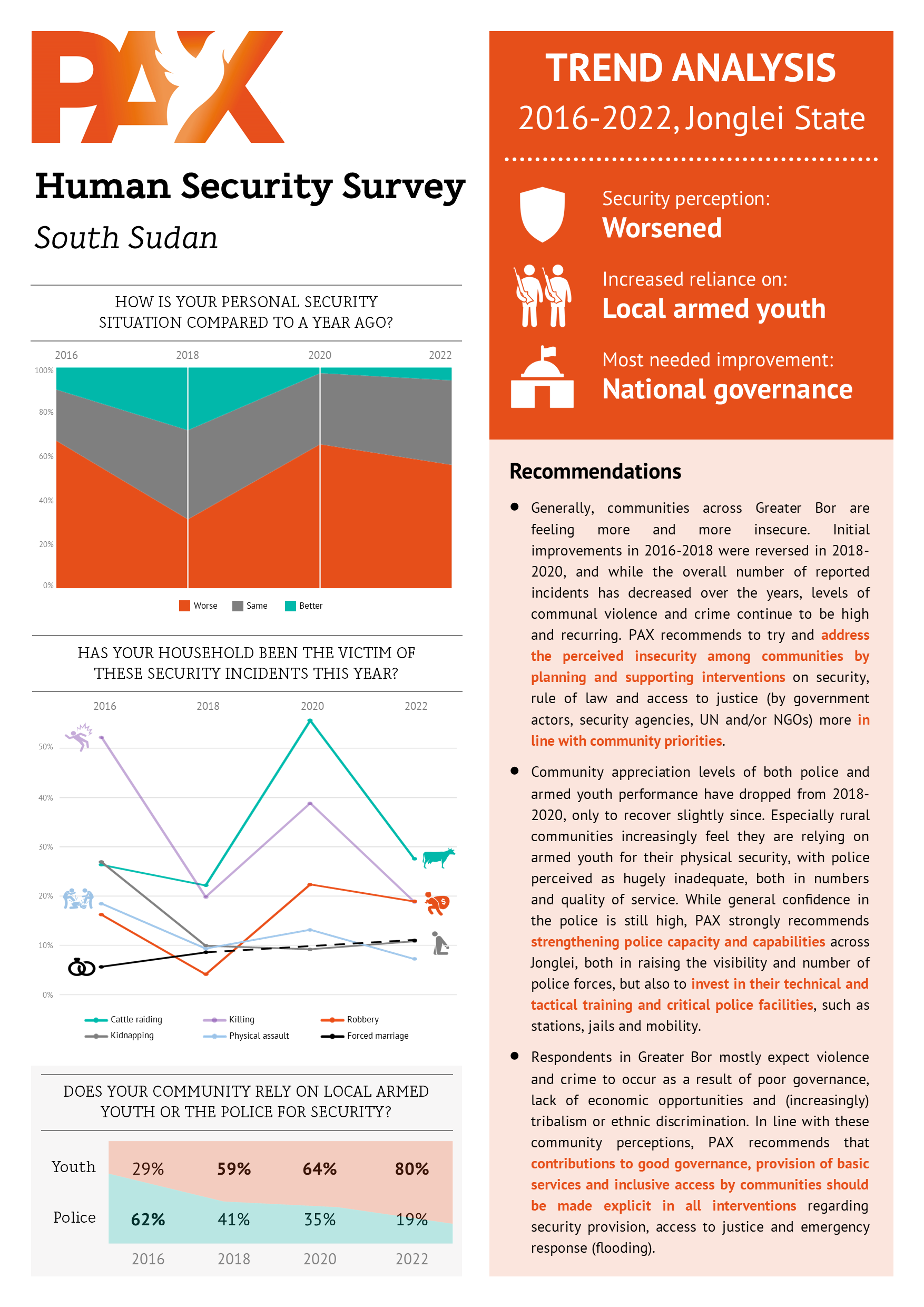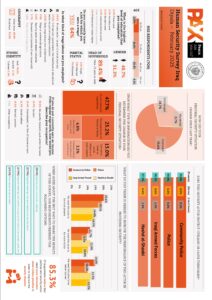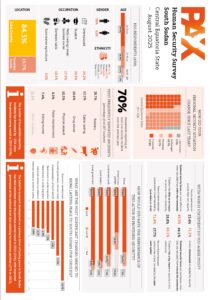HSS 2016-2022: Trend analysis of Jonglei, South Sudan
This document presents the main findings of the Human Security Survey in Jonglei State from 2016 to 2022, as well as trend analysis and recommendations for security actors.
Main conclusions
- Security perception: worsened
- Increased reliance on: local armed youth
- Most needed improvement: national governance
Recommendations
- Generally, communities across Greater Bor are feeling more and more insecure. Initial improvements in 2016-2018 were reversed in 2018-2020, and while the overall number of reported incidents has decreased over the years, levels of communal violence and crime continue to be high and recurring. PAX recommends to try and address the perceived insecurity among communities by planning and supporting interventions on security, rule of law and access to justice (by government actors, security agencies, UN and/or NGOs) more in line with community priorities.
- Community appreciation levels of both police and armed youth performance have dropped from 2018-2020, only to recover slightly since. Especially rural communities increasingly feel they are relying on armed youth for their physical security, with police perceived as hugely inadequate, both in numbers and quality of service. While general confidence in the police is still high, PAX strongly recommends strengthening police capacity and capabilities across Jonglei, both in raising the visibility and number of police forces, but also to invest in their technical and tactical training and critical police facilities, such as stations, jails and mobility.
- Respondents in Greater Bor mostly expect violence and crime to occur as a result of poor governance, lack of economic opportunities and (increasingly) tribalism or ethnic discrimination. In line with these community perceptions, PAX recommends that contributions to good governance, provision of basic services and inclusive access by communities should be made explicit in all interventions regarding security provision, access to justice and emergency response (flooding).
Scroll past the PDF viewer for more details on the employed research methods, demographics of respondents, and methodological choices.
About this infographic
Date of publication:
Jun 13, 2022
Author:
Anton Quist & Anita Hossain
Publisher:
PAX Protection of Civilians
Period:
2016-2022

HSS 2016-2022: Trend analysis of Jonglei, South Sudan
Jun 13, 2022, Anton Quist & Anita Hossain
Read the document here
Methodology
Research methods & respondents Dates & locations This infographic reports on data collected in Jonglei State over 4 rounds: November 2016, March 2018, July 2020, and February 2022. Bor South County and Twic East County were surveyed each round, and Duk County in 3 out of 4 survey rounds. Data collection in 2020 was postponed to July due to COVID. July being in the middle of rainy season, Duk County was inaccessible in 2020 due to flooding. Demographics The HSS enumerators collected 2.315 surveys in Jonglei since 2016: 850 respondents in 2016, 560 in 2018, 468 in 2020, and 437 respondents in 2022. Over the years, respondents overwhelmingly described themselves as Dinka (91%) and Nuer (4%). In 2016-2020, about a third of respondents were men. In 2022, the gender distribution was more or less even. The age distribution was relatively stable across the survey rounds:
Questions
- Please note that respondents were only asked the question "How would you rate the performance of [security actor] in providing security in your area?" if they indicated in the previous question that the security actor was present. These "present" percentages are as follows:
- Local armed youth: 92% (2018), 71% (2020), 83% (2022)
- Police: 89% (2018), 64% (2020), 54% (2022)
- SSPDF: 39% (2018), 17% (2020), 18% (2022)
- UNMISS: 24% (2018), 19% (2020), 12% (2022)
Methodological & visualization choices Removal of percentages
- To facilitate trend analysis, we prioritized global trends over specificity. We omitted percentages from graphs, as they would draw focus to individual data points. Instead, we highlighted changes over years by using connecting line graphs and adding confidence interval bars to column charts.
- Nevertheless, these exact numbers are available on the HSS South Sudan dashboard. Have a look or reach out to us and we will gladly provide more details. (Please note that, to improve legibility of our publications, categories are combined in a fashion appropriate to each individual publication, so some values may differ.)
- The HSS does not survey all residents in its survey locations, but uses sampling methods. As such, our research findings are always an approximation of the true values in the population. We sincerely hope that every reader of our publications is aware of this. When displaying data points from several years side by side with the intent to perform some kind of comparative analysis, it becomes even more prudent to emphasize this uncertainty.
- To that end, we have included 95% confidence interval (CI) bars to graphs that visually allow for them, most notably the column charts. A 95% CI means that, statistically speaking, there is only a 5% chance that the true value is not between the upper and lower limits of the CI. In other words, based on our sample, we can say with 95% certainty that the true value is included in the span of the CI bars.
- As our aim is to conduct applied research leading to timely and practical results, we did not perform statistical tests on the data. The recommendations are based on viewing the data, using multiple data points to support the assertions, in combination with contextual knowledge of our staff.
- Questions included in this infographic stayed more or less the same in the reported years. Some questions and/or answer options were removed or (re)introduced over the years, which is why in a few graphs, some data points are missing.
- In column and bar charts, a missing column means that no data is available for that year.
- In line graphs, the line starts later if the first data point is missing or ends sooner if the last data point is missing. If a middle data point is missing, the two known data points are connected by a dotted line.


